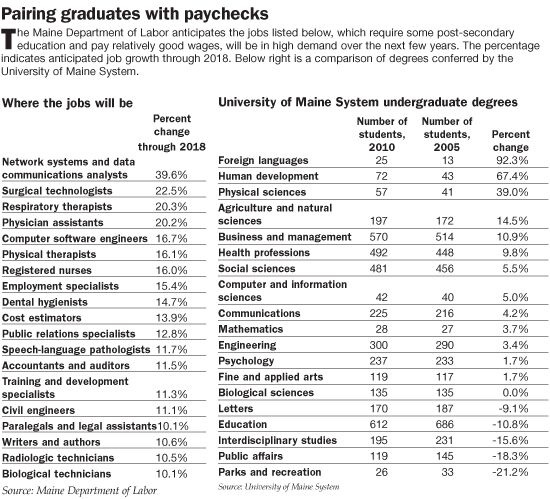Degrees-jobs gap persists

Maine’s universities and colleges have just unleashed the latest batch of graduates into the job market to find their way in an uncertain economy. This spring, the University of Maine System’s seven campuses conferred degrees to about 4,000 undergraduates and 829 graduate, law or doctoral students, according to estimates.
With unemployment hovering around 8%, Maine’s public universities are under pressure to create an educated work force to power the state economy and fill employers’ needs. According to academic year 2009/2010 data, the most recent available, there is still a disconnect between the degrees university students are pursuing and available Maine jobs.
The most popular undergraduate degrees in the academic year 2009/2010 were in the areas of education, business, health and social sciences. Meanwhile, the fastest-growing jobs in Maine are in certain medical fields, along with positions requiring advanced computer skills. But only 42 undergraduates majored in computer and information sciences out of a total 4,102 undergraduates who graduated from Maine’s university system that year, and only seven students received a graduate degree in the field.
The rough economy has had some effect on student choices. Patty Counihan, the director of the career center at the University of Maine, says, “The number has increased of students going on to graduate school and trying to ride out the market and acquire more skills at the same time.” Phil Pratt, associate director at the Office of Institutional Studies at the University of Maine, says in the past five years, the number of students enrolling in graduate school has climbed from approximately one in five to about one in four.
Meanwhile, at the undergraduate level, officials at both the University of Southern Maine and UMaine say communications majors continue to be popular among students. At USM, about 15% of the liberal arts undergraduates earned a bachelor’s degree in either communications or media studies; at UMaine, about 21% of undergraduates in the liberal arts college earned their degree in communications, journalism or new media. The Maine Department of Labor projects job growth through 2018 in public relations specialists (12.8%) and writers, authors (10.6%), while network and data analysts are projected to see a nearly 40% increase in jobs (see accompanying chart.)
Owen Smith, director of the New Media Program at UMaine, says his department, which offers courses in web-based applications, graphic design, hand-held computing applications, applied design, and film and video, has been the fastest-growing department since 2006. He says the popularity stems from the major’s combination of technical and art skills, which are marketable and transportable. “This is an area that attracts people who might have gone into traditional art fields, and they see it as a way to apply their interest in the arts and have a chance at employment,” he says. “Just about every business needs someone to help with online marketing and their website. It’s a huge growth area.”
UMaine’s spokesman, Joe Carr, says in the past couple of years the university has expanded its offerings to meet the needs of students and the state economy, by, for instance, adding an MFA program to its new media department and adding a graduate program in biomedical sciences. Other new graduate programs include anthropology and climate change and an MBA concentration in sustainability. Two years ago, the university launched a masters’ program in the School of Policy and International Affairs “because students had expressed interest in government careers,” Carr says. As baby-boomer bureaucrats begin retiring, younger people will need to step into their places. A new minor in renewable energy will also start up next fall at the university.
Meanwhile, USM has started several new programs in the last few years as well, including a doctoral nursing degree, a risk management and insurance program in the business school, and an art and entrepreneurial studies degree, a collaboration between its art department and business school.










Comments